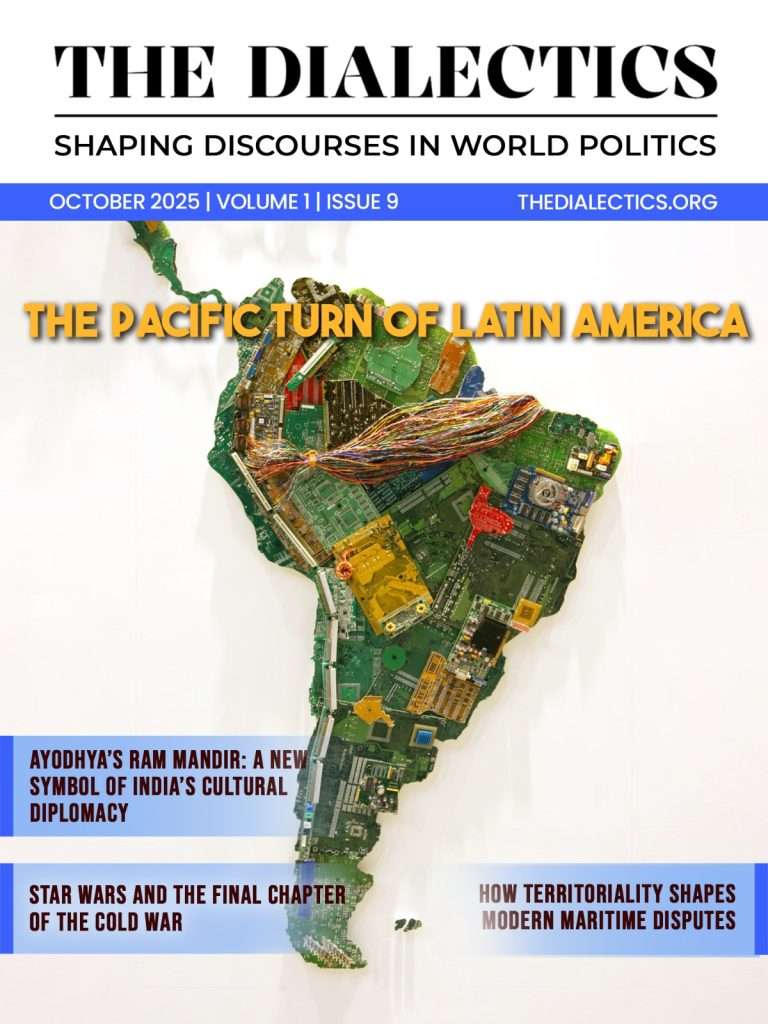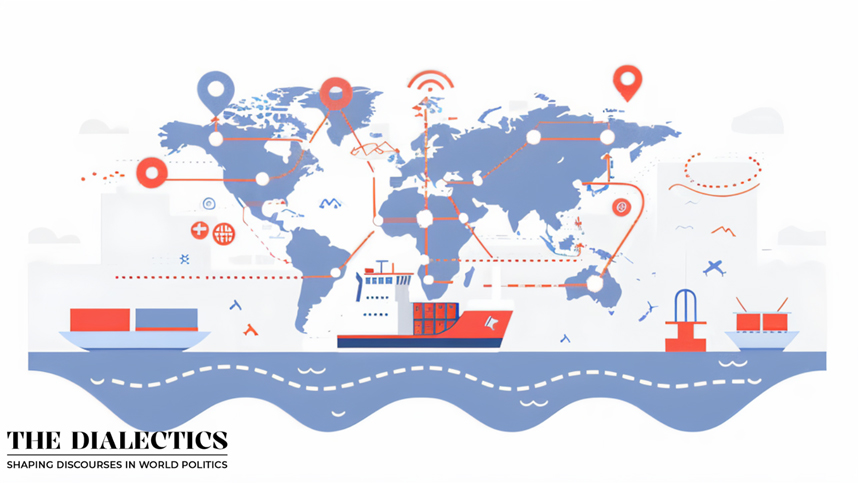Introduction
The Indian Ocean Region (IOR) has emerged has one of the most strategically contested maritime spaces of the 21st Century, hosting critical sea lines of communication (SLOCs), vital chokepoints and resource-rich littoral zones. As global geopolitical competition intensifies, particularly between the United States and China, the IOR’s strategic relevance has increased exponentially. For India, which occupies a central geographic position astride these SLOCs, maritime security is not merely a peripheral concern but a core national interest.
In this evolving landscape, India’s vision of Security and Growth for All in the Region (SAGAR), articulated by Prime Minister Narendra Modi in 2015, serves as a guiding framework for its maritime engagement. SAGAR is premised on inclusivity, capacity-building and cooperative security, positioning India as a net maritime security provider. This role is increasingly operationalized through the deployment of advanced Maritime Domain Awareness (MDA) capabilities – both nationally via the Information Fusion Centre-Indian Ocean Region (IFC-IOR) and multilaterally through the Indo-Pacific Partnership for Maritime Domain Awareness (IPMDA).
MDA provides India with tools to integrate Non-Traditional security threats and Strategic Signalling into a coherent maritime strategy, enabling it to deliver public goods while deterring adversaries. This article examines how MDA operationalizes SAGAR and helps India build trust among IOR littoral states while protecting itself as a responsible and reliable maritime partner.
The Strategic Context of Maritime Domain Awareness in the IOR
The IOR is a complex maritime theatre where multiple layers of security challenges overlap. Littoral states face Traditional Security threats like Piracy, Arms trafficking, maritime terrorism and Non-Traditional threats such as Illegal, Unreported and Unregulated (IUU) fishing, environmental degradation, and the increasingly severe impacts of climate change. India’s MDA capabilities have evolved in response to this environment.
At the core of India’s National MDA architecture is the Information Management and Analysis Centre (IMAC) in Gurugram, linked to coastal radar chains and Automatic Identification System (AIS) data feeds, conceived after the 26/11 attack in Mumbai. Regionally, the IFC-IOR acts as a hub for information sharing with partner states, offering both situational awareness and analytical products. At the multilateral level, India’s participation in IPMDA – a Quad Initiative has expanded its access to satellite based vessel tracking and improved interoperability with partners like the U.S, Australia and Japan.
India’s evolving maritime strategy has increasingly emphasized the integration of Maritime Domain Awareness (MDA) into the normative framework of “Security and Growth for All in the Region (SAGAR). While SAGAR articulates India’s vision for security as a collective pursuit based on shared interest and a framework of morality that respects the “legitimate strategic imperative of all civilised nations”. MDA serves as the operational backbone for translating these principles into practice. By combining real-time surveillance, predictive analytics and coordinated response mechanisms, India has been able to deliver public goods, reinforce international maritime norms and build strategic trust among Indian Ocean littoral states.
SAGAR as a Normative and Operational Framework
SAGAR’s normative appeal provides us with a coherent framework to address some of the challenges relating to economic revival, connectivity, security, culture and identity, and India’s own evolving approach these issues has also prioritised Blue Economy, a multiplication of activities related to Blue economy will call for a more vigilant and efficient role of the coast guard agencies of the IOR littorals. For, only when maritime security is assured that a blue economy which is both capital and skill intensive will be able to attract the required investments.
In the light of prosperity and growth, the maritime challenges persist through Traditional and Non-Traditional Security threats, which need coordinated responses through advanced technological capabilities. The integration of MDA into SAGAR operationalizes these objectives by enabling India to provide actionable intelligence, early warnings, and allow India to monitor vast ocean spaces, detect anomalies, and share relevant information with partners in a calibrated and trust-enhancing manner. This dual emphasis on providing public goods, such as early cyclone warnings, IUU fishing detection, environmental monitoring and reinforcing adherence to international maritime law by ensuring that SAGAR is not merely a rhetorical construct but a living operational reality.
MDA’s Dual Track Role: Non-Traditional Security and Strategic Signalling
This section of MDA’s Dual Track Role emphasizes two important roles played by India’s MDA diplomacy.
- The First is the Non-Traditional Security narrative, which builds India’s legitimacy and soft power through cooperative capacity-building and humanitarian assistance.
- The Second is Strategic Signalling which uses MDA to deter adversaries and reassure partners via calibrated transparency.
On the non-traditional security front, several recent cases highlight how MDA has underpinned India’s regional engagements. In May 2023, during Cyclone Mocha, the Indian Meteorological department (IMD) provided early warnings to Bangladesh and Myanmar, enabling timely evacuations and reducing casualties.
On the strategic signalling front, India’s monitoring of the Chinese vessel Yuan Wang 5 at Hambantota Port in August 2022 conveyed both surveillance capacity and political restraint, avoiding escalation while safeguarding strategic interests. In January 2024, INS Sumitra intercepted the Iranian Fishing vessel AI Naeemi, which had been boarded by pirates, resulting in the crew being taken hostage, later the Ship undertook a confirmatory boarding to ensure the safety of the crew held captive by the Somali Pirates. These incidents illustrate India’s ability to combine transparency with operational precision, effectively sending deterrent signals to adversaries while maintaining its normative image as a cooperative security actor.
Why Littoral States View India as a Responsible Net Security Provider
India’s growing reputation as a net security provider in the Indian Ocean Region is rooted in tangible, consistent operational engagements, Humanitarian Assistance and Disaster Relief (HADR) operations in the Maldives, Mozambique and Sri Lanka following cyclones and floods, have demonstrated India’s capacity to mobilize resources quickly and effectively. Collaborative Engagement and Capacity building against IUU fishing has yielded measurable economic benefits for small coastal states. Counter-piracy patrols and the interdiction of hijacked vessels have reassured shipping-dependent economies of India’s commitment to protecting vital sea lanes. Crucially, these actions are undertaken without imposing hegemonic control, distinguishing India from other extra-regional actors whose security presence often carries strategic strings attached. By filling capability gaps in surveillance, enforcement, and crisis management, India offers a form of maritime partnership that is both operationally valuable and politically acceptable to smaller littoral states.
Conclusion
The Integration of Maritime Domain Awareness into the SAGAR framework will enable India to transition from a declaratory Maritime Vision to a functional, operational leadership role in the Indian Ocean Region. By coupling Non-traditional security threats, such as HADR, IUU and Environmental degradation with Strategic Signalling capabilities, India has managed to reassure vulnerable littoral states while deterring actors that might seek to undermine regional stability. Importantly, these efforts have been conducted without imposing coercive behaviour, preserving India’s image as reliable maritime net security provider.
In Practical terms, India’s operational credibility now rests on its ability to deliver timely assistance during crises, maintain uninterrupted situational awareness across vast maritime zones, resources tracking, ocean mapping and strengthen the institutional capacity of its partners would help both strategically and Blue Economy prosperity. These functions directly address the most pressing opportunities and vulnerabilities of smaller states. At the same time, by embedding MDA within a rules-based order anchored in UNCLOS, India can ensure that its security role is viewed as legitimate not just in strategic terms, but also in legal and normative dimensions and also emphasised.
As the Indian Ocean continues to emerge as one of the Central theatres of 21st Century geopolitical competition, SAGAR’s success will depend on India’s ability to keep delivering results that matter at the ground (and Sea) level. This means not just projecting naval power, but providing tools, training and trust to create a shared maritime security ecosystem. If implemented in this practical, inclusive manner. SAGAR, powered by an expansive and legally grounded MDA network can evolve into both operational backbone and the normative compass of India’s maritime diplomacy for decades to come.




